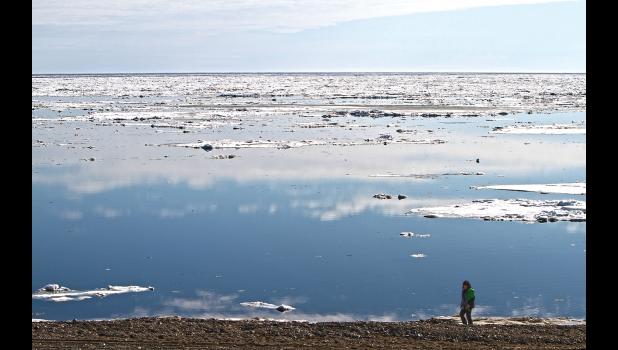Following mild winter, Nome has warmest spring on record
Islands of decaying sea ice bob lazily in the open blue waters of Norton Sound in front of Nome. The beach is ice and snow free, allowing people to leisurely stroll along the shoreline, roast marshmallows on campfires made of drift wood and throw Frisbees for the dog. Spring in Nome arrived early, no doubt.
The National Weather Service data confirms what Nome residents felt all along this winter: that it was unusually warm, albeit a bit windy.
Data shows that between November and March, the average temperature in Nome was 16.2°F, marking the second warmest winter on record for Nome. The warmest winter average temperature occurred in 2000/2001 when the average temperature measured 17.9°F, according to Rick Thoman, Climate Science and Services Manager with the National Weather Service in Fairbanks.
And the warmth continued. In April alone, four records for the daily high temperatures were broken and one record tied. On April 12, the high temperature reached 46°F (old record set in 2004 at 43°F); April 18 the high reached 44°F, a degree warmer than the old record of 2014 at 43°F. April 20 saw a high of 49°F, besting the 2014 record of 47°F. The next day, the thermometer reached 50°F, four degrees warmer than the record set in 1996 at 45°F. April 26 this year tied with the same day in 1940, when the temperatures reached 52°F.
Robert Murders with the National Weather Service office in Nome reports also that the snowfall for the entire season, measured from July of the previous year through May 1, saw only 48.9 inches. Normal snowfall should be 73.2 inches. The previous winter 2014/2015 measured a snowfall of 59.7 inches. Measurable snow on the ground is zero. “Last year at this time, we still had two inches of snow on the ground,” reports Murders.
Thoman put the local data in perspective when he said that Nome and Northwest Alaska are right in the trend of all of Alaska showing an unusually warm winter and spring. “This is the warmest spring ever recorded in Nome,” he said. The average temperature from February through April in Nome measured a whopping 20.6°F. The second warmest spring was in 1989, and last year was the twelfth warmest spring with an average temperature of 18.1°F. “Everywhere from Southeast to Barrow, this confirms a general warming trend,” Thoman told the Nome Nugget.
Thoman said that the average low for Nome, between October 2015 and April 2016 was -17°F. “In recorded history, Nome has never had a winter with a low that warm,” Thoman said. The low in the previous winter was -20°F. The lowest temperature recorded in the state was -47°F at Arctic Village around Christmas time. “It’s never been where the state has not hit the minus 50°F mark somewhere in the state,” Thoman said.
Going into April, Thoman said that starting April 7, Nome’s high temperatures were almost every day above freezing. “Normally, the average high temperature does not go above freezing until April 24,” he said.
“Even some lows were above freezing. The normal date when Nome gets lows above freezing is around May 19,” Thoman said.
The sustained warm temperatures made for relatively mild river breakups. There was no flooding reported, not in Nome’s Snake or Nome rivers. Also, the Kuskokwim saw its earliest breakup ever. Thoman said while the longterm average sees the Kusko flowing at Bethel around May 12, this year’s breakup in Bethel was nearly a month early, on April 20. Thoman said the warm temperatures allow for the ice to rot in place and thus there is no substantial river flooding reported.
However, he said that while Nome and Northwest Alaska saw a milder than usual winter, the deviation from “normal” temperatures was less than in the rest of Alaska.
The low snowfall was primarily the result of weather systems shifting east from the North Pacific into the Gulf of Alaska, dumping most of its moisture south of the Bering Sea. Thoman said much of Western Alaska was drier than average. “Snowfall was below normal almost everywhere, with the exception of Haines.”

